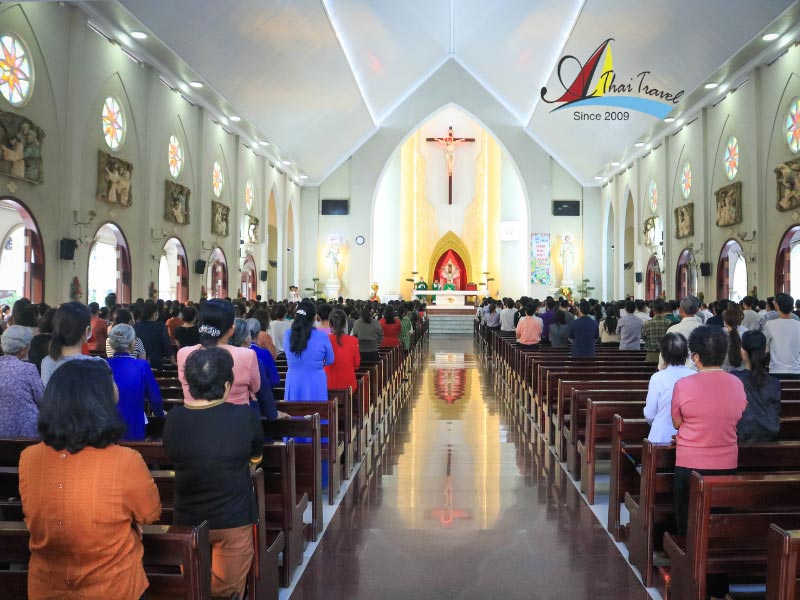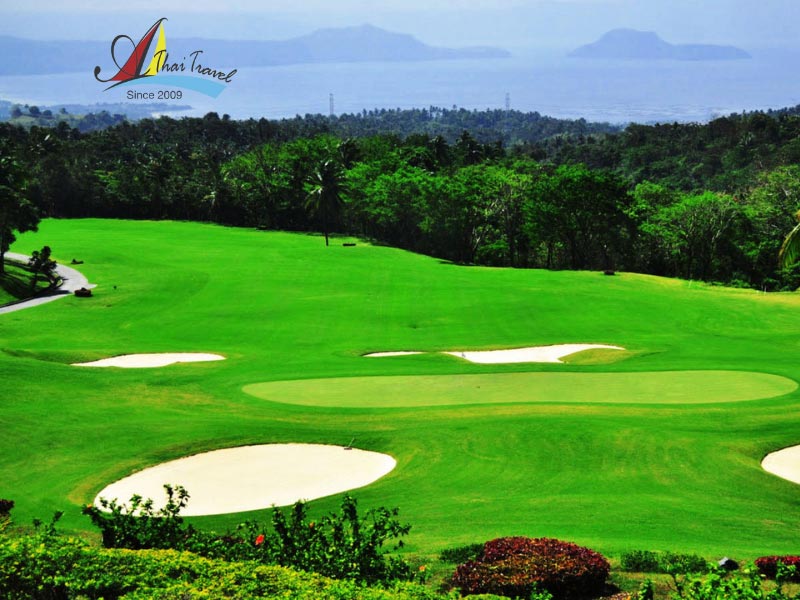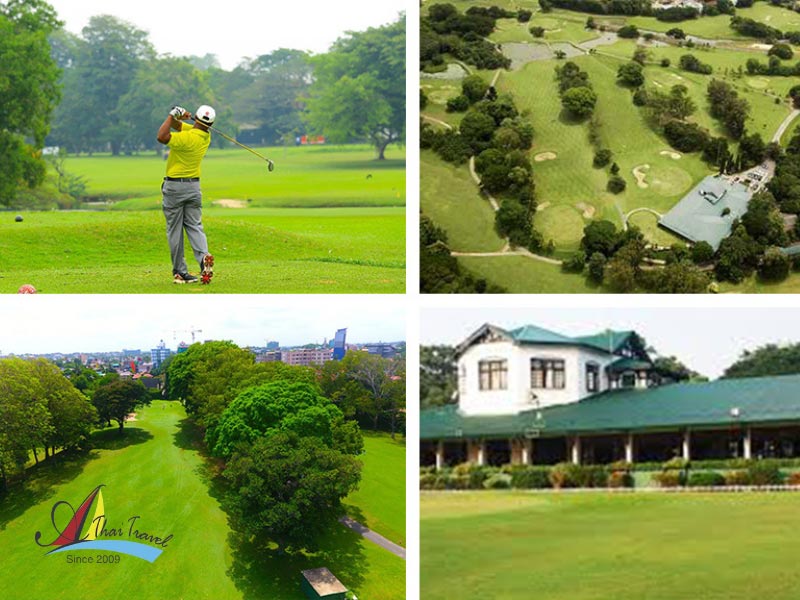Visit Hue ancient capital in central Viet Nam – a land of talented and virtuous people contains countless charming landscapes that enchant visitors. Besides, when it comes to Hue, we surely think of the Complex of Hue Monuments – a cultural tourism icon everyone wants to visit once. Let’s join AThai Travel to visit the ancient capital city of Hue in Central Vietnam to explore the mysterious beauty of this destination.

1. About Hue Imperial City
Hue Vietnam map is a coastal province in Central Vietnam, bordering Laos, the East Sea, Quang Nam, Da Nang, and Quang Tri. Hue is famous for its romantic, peaceful, and gentle beauty, which attracts everyone to visit at least once in their lifetime.
The Imperial City of Hue is located next to the tranquil Perfume River, built by the Nguyen Dynasty in the 19th century. Despite many historical events, the Imperial City remains an icon of ancient beauty and peace in Hue.
From the outside, the Imperial City of Hue appears with its antique and majestic beauty, containing unique architectural works. Visitors here can immerse themselves in the ancient Vietnamese lifestyle with luxurious palace scenes, reminiscent of the heroic history of the country.
Visitors to the Imperial City can admire the golden palaces, solemn tombs, and historical landscapes that give Hue its unique charm. Arrange a trip to visit Hue ancient capital in central Viet Nam to witness and experience the cultural heritage of tangible and intangible objects with great value to the Vietnamese people.

2. The history of formation and development of Hue Imperial City
During a time when our country was divided by “King Le, Lord Trinh”, Hue Imperial City became the residence of 9 Nguyen emperors in Central Vietnam. It was initiated in 1805 under the reign of Emperor Gia Long and lasted for 27 years during the Nguyen dynasty. Hue Imperial City – Ancient Vietnam culture was the capital of the Tay Son dynasty and the Nguyen dynasty.
Built-in a harmonious combination of Eastern and Western styles, it brought about a magnificent and grand construction. During its construction, Hue Imperial City became an important strategic center with a favorable location surrounded by strategic roads such as Phan Dang Luu, Le Duan, and Tran Hung Dao. Throughout that process, the kings of the dynasties always renovated, repaired, and redesigned it to gradually become a work of art reflecting Vietnam ancient capital.
In 1993, the Complex of Hue Monuments was recognized as one of 7 wonders of the world vietnam. This place embodies the heroic beauty of the simple, hardworking, and resilient people who are the symbol of the Vietnamese nation. Visit Hue ancient capital in central Viet Nam is a must-visit tourist destination you should not miss.
It represents the unique artistic achievements, particularly with the masterpieces created by human hands. Hue Imperial City symbolizes the typical architectural ensemble of an important historical period, along with significant events that have had a profound influence on the nation’s historical figures. Thus, the Complex of Hue Monuments is a cultural heritage of humanity that deserves global recognition.

3. The Unique Design Space of Hue Imperial City
Hue ancient capital of Vietnam – Hue Imperial City is structured with three layers of citadels: the Forbidden Citadel, the Imperial City, and the Outer City. The complex boasts an ancient and grandiose beauty, built on an area of over 500 hectares. This rare ancient citadel has preserved its original beauty and primitive architecture, including temples, palaces, and tombs.
Stepping into Hue Imperial City, visitors cannot help but be overwhelmed by the ancient atmosphere. Hue central Vietnam – this is a source of great pride for Vietnamese people in general and Hue residents in particular, welcoming international friends to share in the experience.

4. Discover the must-visit destinations in Hue’s ancient capital
The Imperial Citadel of Hue
The Imperial Citadel of Hue is a fortress of the Hue ancient capital and one of the must-visit tourist destinations in Hue, Vietnam. It is a piece of remaining historical evidence after centuries. Built near the Perfume River, facing the South, it carries a heroic meaning: ruling the whole country. Visit Hue ancient capital in central Viet Nam, you cannot miss this historical site.
The Imperial Citadel of Hue consists of 10 gates, including the North Main Gate, The Nhon Gate, the Southeast Gate, the South Main Gate, the Quang Duc Gate, the Northwest Gate, the Southwest Gate, the East Main Gate, and the Northeast Gate. It was surrounded and built solidly to become the key territory of the nation in the past. With its large space and ancient beauty of thousands of years, the Imperial Citadel of Hue has become a cultural highlight deeply imprinted in the minds of Vietnamese people.
- The Noon Gate is the main gate of the Imperial Citadel of Hue. When arriving here, visitors will admire the palace painting, which is both majestic and intimate. With all the dedication and meticulousness of a glorious dynasty, the Noon Gate is like a new horizon leading visitors to step by step explore tourist attractions in Hue Vietnam.
- Thái Hòa Palace is a special place located in the Hoang Thanh area of the Imperial City of Hue, often hosting important court ceremonies and rituals. Everything here is arranged elegantly and grandly, symbolizing the solemnity of the reigns of the Emperors.
- Not too far away for those who love the beauty of the country’s history, the Temple of Literature (Quoc Tu Giam) appears as a project that brings together many talents of Vietnam. Since ancient times, our people have had a tradition of filial piety and learning, so when King Gia Long began to build the Temple of Literature, it demonstrated the solemnity that would leave a lasting impression for generations to come.
- The Flag Tower (Ky Dai), also known as the Column of Flags, is a solemn place that exudes the national pride of the people in the Imperial City of Hue. Located right on the southern facade of the Imperial City, the Flag Tower is built with bricks, designed to stack up like stairs from large to small. The flagpole is made of wood, but after a period of time, it was renovated and made of iron, reaching a height of over 17m.
- The Nine Dynastic Urns (Cu Ngu) are nine bronze urns that were cast by highly skilled artisans in the second year of King Gia Long’s reign. Each urn is a highly valued work of art due to its cultural beauty and meticulous design. After two relocations, the Nine Dynastic Urns still remain a masterpiece that appears frequently in poetry.

The Forbidden City – Royal Monument in Hue Ancient Capital
Renowned for the vast Hue Ancient Capital, the Forbidden City is a historical monument. Known as the living place of the King, the palace of concubines, the Forbidden City is considered the centerpiece of the Imperial City. Let’s explore what the Forbidden City – Visit Hue ancient capital in central Viet Nam has to offer with Athai Travel.
- The Dai Cung Mon is the main entrance to the Forbidden City with 5 rooms and 3 gates connecting to the Left and Right Guard Houses. This is a construction built by King Minh Mang in 1833. In the past, the King would use the two main gates while the other gates were reserved for the imperial court officials. Due to the long period of time and many wars, the Dai Cung Mon has not been preserved and is currently under restoration.
- The Left and Right Guard Houses are large constructions serving the preparation for the court’s ceremonies. If the Left Guard House is reserved for civil officials, the Right Guard House is for military officials. This place always stands majestic and solemn after years of history, from feudalism to modern life.
- The Can Chanh Palace is a place where the court used to organize banquets, entertain foreign delegations, or for the King to hold court. The construction was built in the third reign of King Gia Long with many beautiful wooden structures, but it has been changed and repaired over many dynasties.
- When it was first built, Can Thanh Palace was called Trung Hoa Palace with the purpose of being used as a place for the king to rest and live? It was also a beautiful and majestic place reserved for the royal family. However, Can Thanh Palace has been destroyed due to war?
- Kien Trung Palace was a place for the king to eat, live, and spend time with his family. It was built in 1921 by King Khai Dinh and its dignity and grandeur served as a testament to the dynasties.
- Initiated by King Khai Dinh in 1919, Thai Binh Lau was where the king came to relax and rest. It was also a place for the king to write poetry, read books, and write literature.
- Located south of Thai Binh Lau, Nhat Thanh Lau is also a special architectural structure built long ago. It is known as the sitting place of the Buddha temple of the King in the Forbidden City.
- Duyet Thi Duong was built to become a theater serving music and drama performances for the King. It was designed in a luxurious and majestic style with unique decorative patterns.

The Royal Tombs
- The Hue Imperial Tomb of Emperor Gia Long not only boasts the most beautiful feng shui location among the Nguyen dynasty royal tombs but is also renowned for the love story between the Emperor and Empress Thua Thien Cao. The tomb, also known as the Thien Tho Tomb, took 6 years to build (1814-1820) and consists of many mausoleums within the Gia Long royal palace. The entire tomb is situated in a pristine mountainous area, surrounded by picturesque landscapes, in Huong Long village, Huong Tra town, Thua Thien Hue province.
- Minh Mang Tomb is surrounded by lush green pine forests and a lotus pond with harmoniously designed structures. In addition to the harmonious space, Minh Mang Tomb brings visitors a sense of solemnity and grandeur.
- With dreamy surrounding trees and a large lake, Tu Duc Tomb offers visitors a serene and peaceful space to explore. The tomb’s design blends seamlessly into the natural landscape and was once a place where King Tu Duc came to write poetry.
- The Khai Dinh Tomb is the most beautiful and unique tomb in the system of tombs in Hue, featuring a blend of various architectural styles. Also known as the Ung Tomb, the Khai Dinh Tomb is one of the seven most beautiful tombs in Hue. The tomb is located on Chau Chu Mountain in Thuy Bang commune, Huong Thuy district, over 10km away from the city center of Hue. Construction of the Khai Dinh Tomb began on September 4th, 1920, and took 11 years to complete, the longest of all tombs in Hue. The commanding officer in charge of building the Khai Dinh Tomb was Tien Quan Do Thong Phu Le Van Ba. Although it has the smallest area among the tombs, the Khai Dinh Tomb boasts the most unique and exquisite architecture, combining Eastern and Western styles in a delicate and sophisticated way.

An Dinh Palace
Cung An Dinh has a total area of 23,463 square meters with a variety of different architectural structures to serve the living and entertainment needs of its owners. It was first built for King Khai Dinh when he was still a prince and later inherited by King An Dinh. The palace’s design features an ancient and delicate style, enhanced by its picturesque location.
In the past, it consisted of 10 different structures, including the Boat Dock, the Main Gate, Khai Tuong Pavilion, Trung Lap Shrine, Cuu Tu Dai Theater, the Water Lake, the Animal House, and more. However, after going through a long history with many fluctuations and weather factors, now only three main structures remain for tourists to visit and admire, including the Main Gate, Trung Lap Shrine, and Khai Tuong Pavilion.

Hue Temple of Literature
Hue Temple of Literature was built by King Gia Long in 1808 and boasts a majestic and solemn atmosphere on the banks of the Perfume River. Tourists who visit Hue ancient capital in central Viet Nam can experience this unique design.

Hon Chen Palace
Hon Chen Palace is a temple dedicated to the Holy Mother located in the mountains, named after the mountain peak Ngoc Tran, which means “jade bowl”. There are about 10 architectural structures designed to surround the palace.

Nam Giao Esplanade
In the past, the royal court always held ceremonies to worship heaven and earth at the beginning of each dry or flood season. Nam Giao Esplanade was chosen as the sacred place for the King to carry out these rituals. Until today, Nam Giao Esplanade remains a popular check-in spot for tourists to visit Hue ancient capital in central Viet Nam, with its romantic and serene green landscape. The space here is both romantic and peaceful, bringing a pristine and tranquil scenery.

Thien Mu Pagoda
Visiting Hue Vietnam, Thien Mu Pagoda in the ancient capital of Hue is a familiar destination for those who love to travel and visit Hue, Vietnam. The construction of this place started in 1601 by Lord Nguyen Hoang during that time.
Thien Mu Pagoda brings a landscape that is both ancient and mysterious, leaving a lasting impression on those who visit. This place contains many mysterious stories such as Dinh Huong Nguyen, and Dien Dai Tang, with harmonious Oriental architecture.

Perfume River
The peaceful and green Perfume River lies in the heart of the ancient capital of Hue, like a serene and calm silk strip. Visit Hue ancient capital in central Viet Nam, the Perfume River becomes a symbol of the ancient capital.
When visiting the Perfume River, tourists can sit on boats and enjoy the peaceful scenery of Hue, admire the ancient citadel of Hue, or the silent city along the riverbank. At night, listening to Hue singing on Perfume River is a unique cultural activity.
Despite not being long and wide, on Perfume River, tourists will always feel the peaceful and gentle nature of a green silk strip flowing throughout all four seasons, always dreamy and gentle. Perfume River always knows how to captivate tourists, so that when they come to Hue, no one can resist stopping by Perfume River to visit an old friend they haven’t seen in a long time. On the small boat, Perfume River takes tourists past the lush Vy Da garden, up to the upper stream to listen to the sound of the temple bell echoing at Thien Mu Pagoda, and then slowly drifting along with the clouds at Huyen Khong pier.

Lang Co Bay
Lang Co Bay is considered one of the must-visit destinations when traveling to visit Hue ancient capital in central Viet Nam. From the viewpoint of Hai Van Pass, Lang Co exudes a charming and peaceful beauty, and as visitors approach closer, they will be overwhelmed by the pure scent of the sea and the intense fragrance of the wind blowing straight into their noses, making them dazed. Lang Co leaves a profound impression on visitors to Hue with its light blue sea water, smooth golden sand under the sun, and vivid red houses standing out against the sky. Lang Co remains beautiful, spacious, and sweet like the hospitable love of the local fishermen, making visitors reluctant to leave.
Voted as the most beautiful bay in the world, Lang Co Bay offers smooth white sand strips, clear blue water, and tranquility that allow visitors to immerse themselves in the harmony with peaceful nature.

Trang Tien Bridge
Trang Tien Bridge is the symbol of the dreamy and magical land of this ancient capital city. If you visit Hue ancient capital in central Viet Nam without seeing Trang Tien Bridge, you cannot say you have been to Hue. The bridge has a total of 6 steel span arches, with the northern side belonging to the Phu Hoa ward and the southern side belonging to the Phu Hoi ward. In the middle is a wide lane for motorized vehicles, with two lanes on either side for pedestrians. Walking around Trang Tien Bridge, visitors not only have the opportunity to admire the beauty of the gentle Huong River and the bustling cityscape but also learn more about the important historical milestones that the bridge has witnessed during the two resistance wars against the American imperialists and the French colonialists.

AThai Travel has just shared all the necessary information for visitors to prepare for their trip to visit Hue ancient capital in central Viet Nam – a famous long-standing historical site. Hopefully, you have gained an objective view and discovered new destinations to have a memorable vacation in the beloved and beautiful land of Hue.
After keeping all the travel experiences in Hue in mind, don’t forget to visit AThai Travel to book a Hue tour for yourself and your loved ones. AThai Travel’s Hue tours are currently on sale with many promotions, so call the hotline: (+84) 98.339.3488 to book the tour quickly!

 Tiếng Việt
Tiếng Việt















